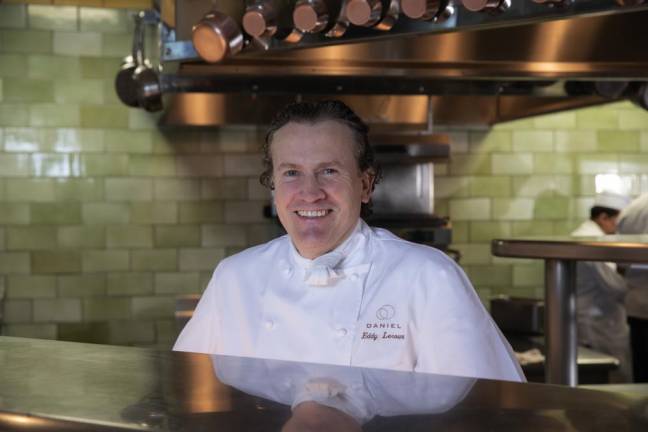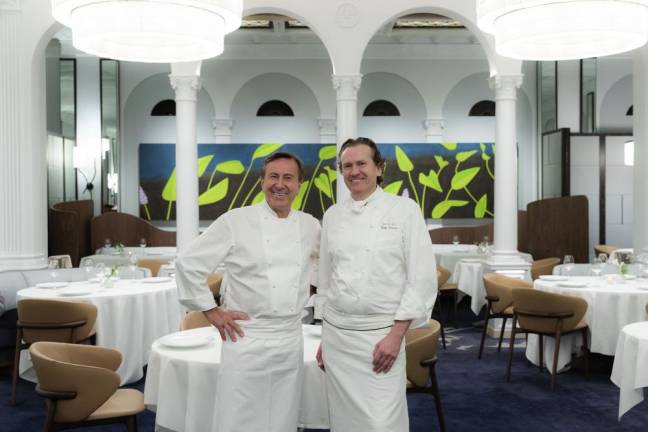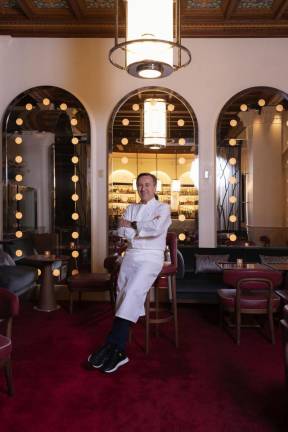Upholding the Traditions of Fine Dining While Staying Current in Changing Times
Newly appointed executive chef at Daniel, Eddy Leroux, dishes on reopening the culinary landmark



After the pandemic temporarily shuttered indoor dining at Daniel, Eddy Leroux, promoted to executive chef during that time, worked closely alongside chef-owner Daniel Boulud to retain its traditional roots, while recognizing, especially after this past year, the need for modernization in an-ever changing world.
The iconic Michelin-starred restaurant, housed on East 65th between Madison and Park, has been a beacon of fine dining in Manhattan since 1993. Officially reopening post-pandemic in September, its new look includes a reimagining of its 3,000 square foot dining room, an Art Deco inspired renovation of the bar, and launch of an art program with exhibits that rotate biannually. As for the food, Leroux, who was trained in classical French cuisine, assured us that the fundamentals of the cooking at Daniel remained untouched. “What we did is refresh the dishes and make them more aesthetic because of the renovation,” he explained. “We wanted to be more in tune with the time we are living.”
A native of northern France, the now 51-year-old began as an apprentice at just 14, but, at the insistence of his parents, continued his academic studies and earned a bachelor’s degree before devoting his professional life to the culinary arts. His impressive resume includes stints in acclaimed eateries from Paris to Bangkok and in 1998, he came to a crossroads when he was offered a five-year contract at the Mandarin Oriental in Bangkok and a spot at the renowned Waldorf Astoria. Needless to say, he ultimately took the opportunity to relocate here “because the appeal was more to New York.”
The already accomplished Leroux met Boulud in March of 2002 when he cooked for the distinguished chef’s Citymeals on Wheels gala, and has been at Daniel ever since that summer, beginning as executive sous chef, then moving up to chef de cuisine and honored with the title of executive chef in April of this year.
We sat down with the Upper East Side resident one afternoon as the restaurant prepped for its dinner service. He gave us a behind-the-scenes look into his life in the kitchen, highlighting his almost-decade-long career at Daniel masterfully preparing delicacies such as foie gras to a frequently requested off-the-menu item, scrambled eggs with truffles, which is always whipped up when in season “because Daniel never says ‘no,’ so we never say ‘no’ either.”
Tell us about the Waldorf Astoria.
In January of 1998, I started at the Waldorf Astoria with the former chef of Alain Ducasse, Laurent Gras, who was the executive chef for Peacock Alley at that time. So we stayed together until 2001. Because of the attacks, they decided to close the restaurant at the Waldorf. They all moved to San Francisco and I stayed at the Waldorf doing banquets. So I saw a huge volume, it was totally a new experience. Because back then at the Waldorf, I used to do parties of 2,000. It was really well done there; the organization was unbelievable. In March of 2002, I met Daniel and since then, I’m here.
You met Daniel at a Citymeals on Wheels event.
Yes, because Daniel does Citymeals every March every year, so that year was a tribute to Guy Savoy, so all former chefs from Guy Savoy executed a dish for the gala dinner, so Gordon Ramsey was there and Laurent Gras, who used to be the chef for Guy Savoy when he was 23 years old. So he asked me to help him out when we did the special dinner there. And then I met Daniel after, and it was a good move for me to leave. I mean, I knew that the Waldorf was just a transition because I was under a visa, so could not go anywhere, I was stuck in a way. So Daniel sponsored everything and I came onboard in June 2002.
This year, you were promoted to executive chef from chef de cuisine. How have your responsibilities changed?
Basically, it’s number one, number two, so when number one is not here, number two is. We work in tandem. Of course, executive chef, you have a title, but it’s pretty much the same responsibility because you cover when one is not here. And we divide the positions in the kitchen. So now I have Joshua Capone as chef de cuisine who has been with us for eight years and he is now taking my position. I have Romain Paumier from Café Boulud as executive sous chef. So we’ve all been groomed slowly but surely all these years.
What did you keep or change on the menu and why?
We didn’t change the fundamentals of Daniel per se in terms of cooking. We’ve always been extremely rigid about the French cuisine based on the classical training we all have. What we did is refresh the dishes and make them more aesthetic because of the renovation; we wanted to be more in tune with the time we are living and be more modern by the aesthetic as well as the flavor by tuning down fat content. [As for] presentation, we changed the plates. So it’s more an aesthetic phase than really a fundamental change of the cuisine. A dish at Daniel is seven to eight weeks. We’re extremely seasonal and based on what the prime product will be during the time that we have the dish on the menu.
How much collaboration do you have with Daniel?
When we change the menu, we always establish meetings. In the summertime, we already are in line for the fall, for example. Like any business, you always work three to six months in advance to what’s going to be the main characteristic of the menu. Then we elaborate with the team, we have weekly meetings with our sous chefs ... We divide our work, we do some tastings, and then when we’re ready, we present to chef. That’s when we’ll decide if it still goes on the menu or if it needs to be changed fundamentally.
What are the most popular dishes on the menu?
It’s always been beef. Beef, crab, lobster, scallops, foie gras. We do two types of foie gras - always a terrine and always a foie gras flambe in the dining room. That’s always been on the menu at Daniel and we’re still doing it because we like to do carving in front of the customers, which not too many restaurants do because it takes a lot of manpower to do it. It’s always been a highlight of Daniel.
What are the best and worst parts of your job?
I mean, the best part, for me, it’s always been the creativity, the time I have to research, the time I have to execute a new dish. And then, I would say, the least is the service time because the stress builds and you try to be yourself but it’s really stressful ... it’s almost seven hours of service. That’s the most challenging part of what we do here, is to make sure that when we do a dish on the menu, it’s executed the same way the first time to the thousandth time. And when you train young chefs, that’s the most difficult part, to keep the same momentum and the same level of execution day after day.
When you go out to eat in the city, where do you go?
Low key, because I know if I go to the same profile of restaurant, I will have to finish my wife’s plate because she’s not a big eater. I avoid having the tasting menu, but unfortunately, as a chef you want to treat the other chef, so they always greet us with an amazing tasting menu, but sometimes it’s a lot of food. So I go low key. I love Japanese. That’s the best thing for me to be in New York because literally all the cuisine in the world is based in New York and the best chefs in the world are in New York anyway, so you can experience amazing cuisine from Afghan to Romania. You name it, you have it.
Follow Chef Eddy on Instagram @lerouxeddy
www.danielnyc.com